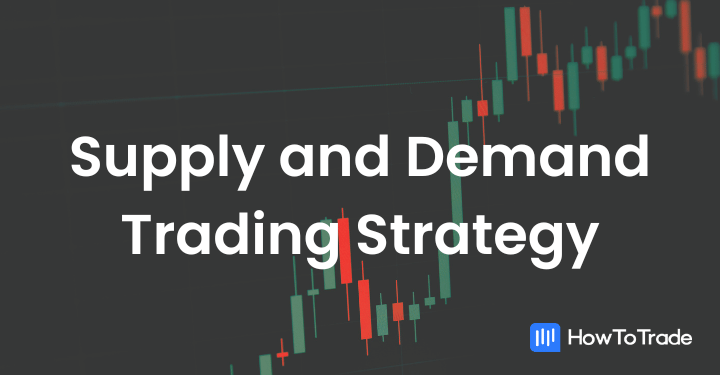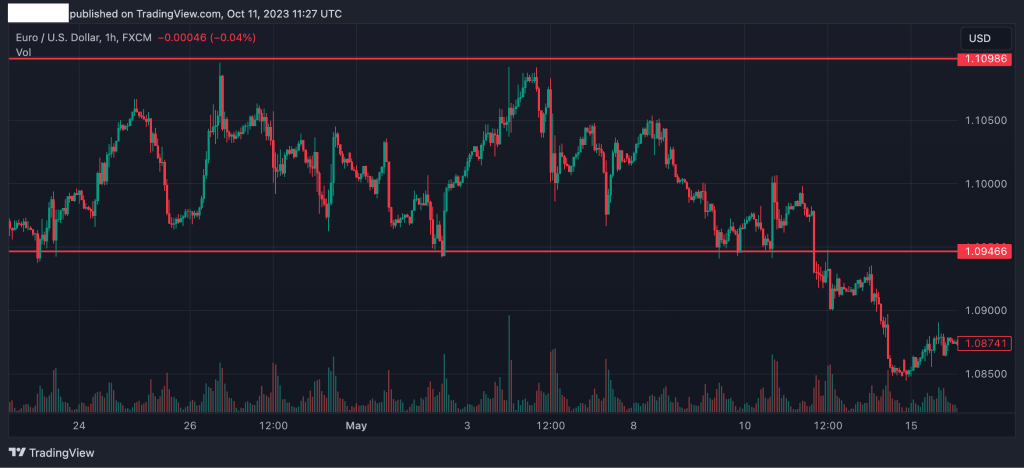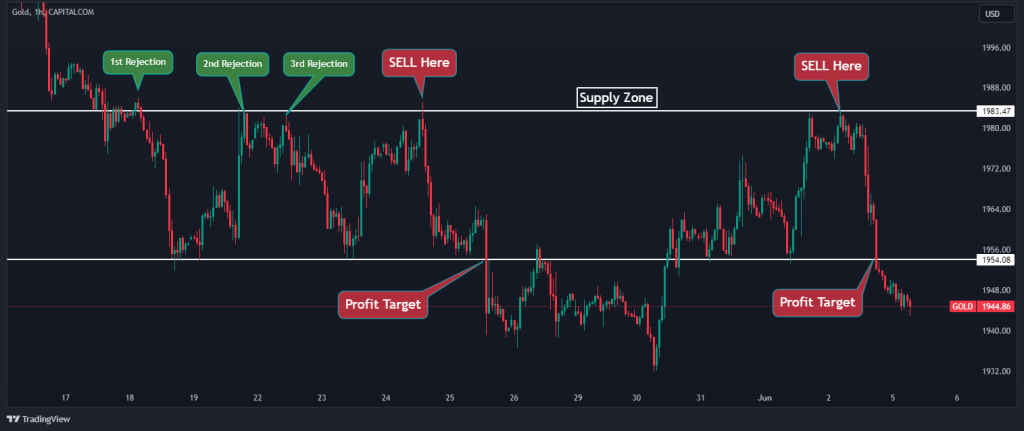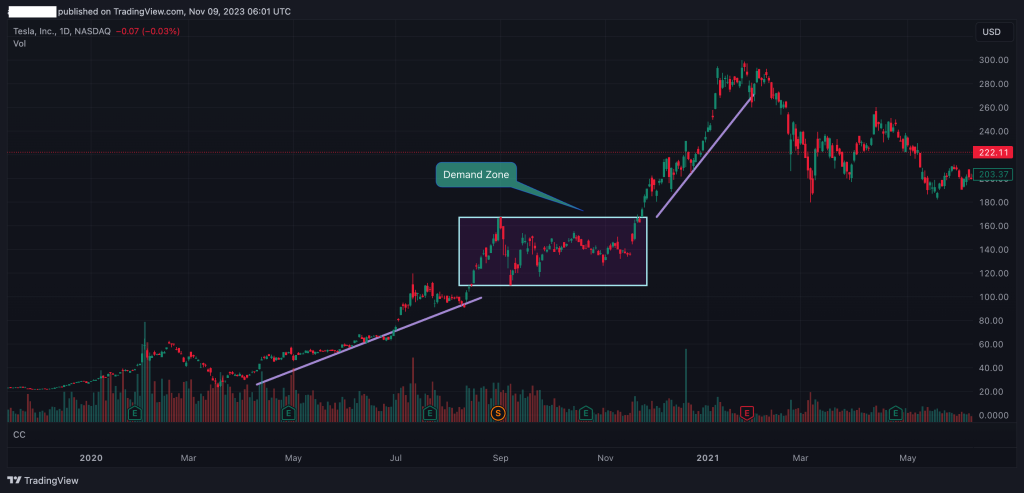
- The supply and demand trading strategy focuses on locating ‘supply zones’ where there is potential selling pressure due to surplus and ‘demand zones’ where buying pressure exists due to scarcity.
- Price action within these supply and demand zones offers clues about market sentiment and potential future movements. Traders look for patterns such as consolidation, sudden spikes, or drops in price to inform their trading decisions.
- Technical analysis tools, such as trend lines, volume, moving averages, and candlestick patterns, are employed to identify and confirm supply and demand zones.
- In addition to technical analysis, fundamental analysis plays a crucial role in understanding the reasons behind supply and demand imbalances. Economic reports, news events, and company earnings can all affect the perception of an asset’s value.
Suppose you have been active on social media recently. In that case, you are likely to have heard traders raving about a certain profitable trading strategy they’ve come to discover – the supply and demand trading strategy.
This trading strategy is rooted in the fundamental economic principle that price reflects the balance between the quantities of goods or services available and the desire for them. In the trading context, this strategy involves identifying zones where the price has historically reacted strongly, suggesting areas of significant buying or selling pressure.
In this article, you’ll learn:
- The idea behind supply and demand
- How to identify and draw supply and demand areas
- Tips and techniques to trade supply and demand
- An example of the supply and demand trading strategy
 Table of Contents
Table of Contents
What is Supply and Demand in Trading?
Understanding the supply and demand dynamics is crucial for traders across all financial markets. This concept is rooted in the basic economic principles outlined by philosopher John Locke in the 17th century. Locke’s seminal work on the impact of supply and demand on pricing remains relevant today, providing a foundational framework for one of the simplest yet most effective trading strategies.
Practically, supply and demand in trading refer to the relationship between the sellers’ willingness to sell a commodity and the buyers’ willingness to purchase it. The price of any asset is directly influenced by this balance (or imbalance) of supply and demand. When an item is scarce but highly sought after, its price tends to rise, and vice versa.
Knowing the impact of supply and demand is not just about observing current market conditions; it’s also about anticipating future changes. Traders generally use technical analysis to identify these supply and demand zones. Fundamental analysis, which evaluates economic indicators, company earnings, and news events, also plays a vital role in assessing how supply and demand may shift.
In short, incorporating supply and demand into trading strategies requires an understanding of market psychology and the ability to read the story told by price charts. It’s about recognizing when prices approach a supply and demand zone; hence, where buyers and sellers previously entered the market aggressively, there’s potential for the price to bounce upward or downward.
How to Identify and Draw Supply and Demand Zones?
Okay, so supply and demand is pretty much an abstract concept. The real challenge is to identify these areas and learn how to use them to find trading opportunities. But how does one spot these critical regions on a chart?
Firstly, supply and demand zones are areas where price has made a significant move either up or down. A demand zone is typically below the current price, where buyers have entered the market aggressively in the past, pushing the price upwards. Conversely, a supply zone is above the current price, where sellers have come in strong, driving the price down.
To identify these zones, you need to look for areas on the chart where the price has had two or three rejections, which indicates a strong area of supply or demand. These rejections show that there is a concentration of buyers or sellers at that price level. For instance, if you see a stock that bounces upwards every time it hits a certain price level, you’ve likely found a demand zone. Similarly, if the price drops after hitting a specific level, you’ve identified a supply zone.
Now, let’s talk about drawing these zones. The process is more of an art than a science, but there are some guidelines you can follow:
- Identify the points where the price has touched and then reversed. These are your initial markers for the zone’s boundaries.
- Using horizontal lines, draw lines connecting these points. For a demand zone, the lower horizontal line is where the price stops falling and starts to rise, while for a supply zone, it’s the opposite.
- Over time, adjust your zones based on new price action. If a zone is continually respected, it remains valid. If it’s breached significantly, it may need to be redrawn.
Check the chart below for an example of how to identify and draw supply and demand zones.

As you can see in the EUR/USD 1H chart above, the price could not break the 1.0945 level three times and the 1.0985 twice. This is a classic case of supply and demand zones, which can be by traders to utilize the range trading strategy or once the price breaks below or above the range, the breakout strategy.
Remember, while drawing these zones, you’re not just predicting market movements; you’re preparing to act on them. The zones give you a visual representation of where significant buying and selling pressures have occurred, allowing you to anticipate potential entry and exit points for your trades.
5 Tips and Techniques for Supply and Demand Trading
Navigating the markets with a supply and demand trading strategy requires the right tools and techniques. So here are five basic and essential tips and techniques that can help you harness the power of supply and demand in your trading journey.
1. Understand the Role of Volume
Volume is the lifeblood of the markets, and when it comes to supply and demand trading, it’s an indispensable indicator. Low trading volume may indicate a lack of conviction in a price move, whereas high volume can confirm the strength of a supply or demand zone. Pay attention to volume spikes—these often precede significant price movements and can signal the formation or breakdown of supply and demand zones.
2. Identify Large Order Blocks
Large order blocks can act as magnets for price. These are areas where institutions and large traders have placed significant orders and can represent key supply or demand zones. By identifying these blocks, you can gain insights into potential barriers to price movement and align your trades with the momentum of these market movers.
3. Utilize Moving Averages
Moving averages smooth out price data to reveal the underlying trend and can be particularly useful in conjunction with supply and demand zones. They help in filtering out the ‘noise’ and confirming trends. A price bouncing off a moving average within a supply or demand zone can offer a robust trading signal.
4. Incorporate Fibonacci Retracements
Fibonacci retracements are a trader’s compass, providing guidance on potential reversal points in the market. When a price retraces to a key Fibonacci level near a supply or demand zone, it can act as an additional layer of confirmation for the strength of that zone. This confluence can be a powerful signal for entry or exit.
5. Watch for Round Numbers
Prices often gravitate towards round numbers, which can act as psychological support and resistance levels. These levels are easy to remember, making them focal points for placing orders. When a supply or demand zone aligns with a round number, it can reinforce the zone’s significance and potentially lead to stronger price reactions.
“Price fluctuations occur when supply and demand are out of balance.”
How to Trade the Supply and Demand Trading Strategy?
Now, let’s quickly put together all we’ve learned and analyze the chart in real-time.
There are many ways to trade using the supply and demand strategy. One way is to look for supply and demand zones in a sideways market.
From the chart below, you can see that the gold price rejected a supply zone three times, and we can anticipate a sell entry whenever the price returns to this zone. As a result, we were able to take two profitable sell entries from this supply zone.

At the same time, we could have used the demand zone to identify buy entry levels. Moreover, once the price breaks below the demand level, we can identify this level as a breakout entry point.
Alternatively, we can also identify supply and demand during an ongoing trend.
For example, take a look at the Tesla daily chart below; a demand/supply zone was formed during an upward trend. In this case, we have a rally-base-rally formation, where the demand/supply zone is formed from the consolidation that follows the initial impulsive move. We placed a buy order when the price broke above the demand/supply zone.

In sum, here’s a step-by-step guide to help you trade the supply and demand trading strategy:
- Identify clear supply or demand zones with multiple price rejections after consolidation.
- Look for reversal candlestick patterns within the zone for trade confirmation.
- Place entry orders following candlestick confirmation with stop losses just outside the zone.
- Set take profit levels at previous significant highs or lows or opposite supply or demand zones.
- Monitor the trade’s progress and adjust stop losses to secure profits as the price moves.
Conclusion
To wrap up, the supply and demand trading strategy distills the complex world of trading into understandable zones of buying and selling pressure. This strategy, rooted in the fundamental economic laws of scarcity and surplus, offers a pragmatic approach to trading that aligns with the intrinsic value perceptions in the market.
Give this strategy a go, and you may find yourself making more calculated and confident trades that align with the market’s sentiment. And remember, if you need help understanding the concept of supply and demand and many other trading strategies, you can join our trading academy, where you can learn from our trading coaches and join our trading community.
Frequently Asked Questions about Supply and Demand Trading
Here are some frequently asked questions about supply and demand trading strategy:
Is supply and demand trading effective?
Yes, supply and demand trading is an effective strategy used by many traders. It’s based on the fundamental economic principle that the imbalance between buyers and sellers drives price movement. When demand exceeds supply, prices tend to rise, and when supply exceeds demand, prices tend to fall. Traders who can accurately identify supply and demand zones can potentially capitalize on these price movements.
What is the best timeframe for supply and demand?
Many traders find the 1-hour (1H) timeframe to be a good balance for supply and demand analysis. It provides enough detail to identify short-term price movements while filtering out some of the ‘noise’ that can occur in shorter timeframes, like the 1-minute or 5-minute charts. The 1H timeframe can offer a clearer view of how supply and demand are affecting price without the need to constantly monitor the markets, making it suitable for both day traders and those with a longer-term perspective.
Is the supply and demand strategy good for beginners?
Supply and demand trading can certainly be a good strategy for beginners because it is based on a simple and intuitive concept. However, while the concept itself is straightforward, applying it successfully in real-time trading requires an understanding of market dynamics and the ability to interpret price charts and economic events. Beginners should start by learning how to identify supply and demand zones and practice with historical data or a demo account before trading with real money.
Risk Disclosure: The information provided in this article is not intended to give financial advice, recommend investments, guarantee profits, or shield you from losses. Our content is only for informational purposes and to help you understand the risks and complexity of these markets by providing objective analysis. Before trading, carefully consider your experience, financial goals, and risk tolerance. Trading involves significant potential for financial loss and isn't suitable for everyone.



